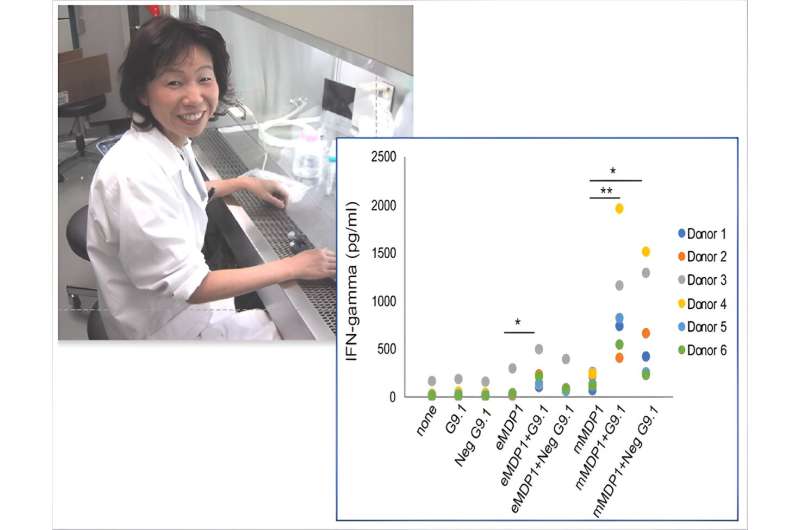This article has been reviewed according to Science X's editorial process and policies. Editors have highlighted the following attributes while ensuring the content's credibility:
fact-checked
peer-reviewed publication
trusted source
proofread
New tuberculosis vaccine candidate shows promise with post-translational modifications

Tuberculosis is still one of the deadliest infectious diseases, causing over one million deaths each year worldwide. Additionally, about one-fourth of the world's population carries Mycobacterium tuberculosis without showing any symptoms, and most of these carriers do not develop the disease.
The current anti-tuberculosis vaccine, BCG, is administered worldwide. However, considering that more than 10 million new tuberculosis cases are reported each year, its effectiveness is deemed insufficient. As a result, the development of vaccines to replace BCG is underway.
However, no new vaccine has yet surpassed BCG, which is a highly effective live vaccine. Actually, BCG is very effective in preventing tuberculosis in children, creating a booster vaccine to strengthen immunity in adults is considered a promising and realistic option.
In developing tuberculosis vaccines, scientists have studied proteins from M. tuberculosis that trigger protective immunity against tuberculosis. IFN-gamma produced by T cells is especially known to be critical for protection against tuberculosis. Thus, IFN-gamma responses are markers of vaccine candidate antigens and efficacy.
However, there's a paradoxical situation where proteins that induce higher IFN-gamma production in tuberculosis patients, who already have developed the disease, rather than in asymptomatic carriers who prevent its onset, are being viewed as potential vaccine candidates.
Furthermore, many vaccine studies ignore the native three-dimensional structure of the proteins and the modification they undergo after being translated in M. tuberculosis.
On the productivity side, vaccine candidate molecules are being made in basic model organisms like Escherichia coli. However, certain molecules undergo specific changes after translation that are unique to the pathogen, such as M. tuberculosis.
It's been noted that these modifications might be crucial for mounting effective defenses against actual pathogen attacks.
Mycobacterial DNA-binding protein 1 (MDP1) is a major protein of both BCG and M. tuberculosis with extensive post-translational modifications. Recent studies show that IFN-gamma responses to MDP1 are higher in individuals who suppress tuberculosis progression compared to tuberculosis patients, making MDP1 a new vaccine candidate.
To evaluate MDP1 for a tuberculosis booster vaccine, Yuriko Ozeki and colleagues produced recombinant MDP1 and tested its ability to induce IFN-gamma using blood from BCG-vaccinated adults. The paper is published in the journal Scientific Reports.
The researchers expressed MDP1 in two different hosts: M. smegmatis, a non-pathogenic, fast-growing mycobacteria, and E. coli. Importantly, the MDP1 expressed in M. smegmatis (mMDP1) showed significant post-translational modifications, closely resembling the native MDP1 found in M. tuberculosis, while the one expressed in E. coli (eMDP1) did not.
When they cultured both variants of MDP1 with peripheral blood from adults vaccinated with BCG, they observed that mMDP1 triggered notably higher levels of IFN-gamma production compared to eMDP1. This implies that the immune system of BCG-vaccinated adults can recognize MDP1 with post-translational modifications.
Importantly, mMDP1 demonstrated a superior capacity for IFN-gamma production compared to other vaccine candidate antigens, such as Antigen 85 complex, which is currently in development.
When utilizing protein antigens as vaccines, adjuvants are typically employed to prevent degradation or enhance immunogenicity. The team previously reported that MDP1, due to its binding affinity to bacterial DNA, has protected mice from M. tuberculosis infection when co-administered.
In this study they also demonstrated that the combination of mMDP1 and G9.1, a novel type of CpG-DNA, elicits a significant level of IFN-gamma from peripheral blood of BCG-vaccinated adults.
The results of this study suggest that combining mMDP1, which displays post-translational modifications, with G9.1 can reinvigorate the waning effect of BCG, indicating its potential as a booster vaccine.
More information: Yuriko Ozeki et al, Recombinant mycobacterial DNA-binding protein 1 with post-translational modifications boosts IFN-gamma production from BCG-vaccinated individuals' blood cells in combination with CpG-DNA, Scientific Reports (2024). DOI: 10.1038/s41598-024-58836-8




















